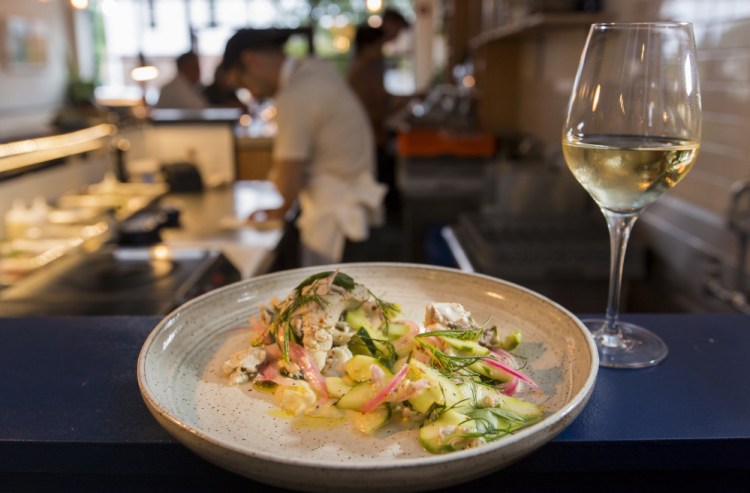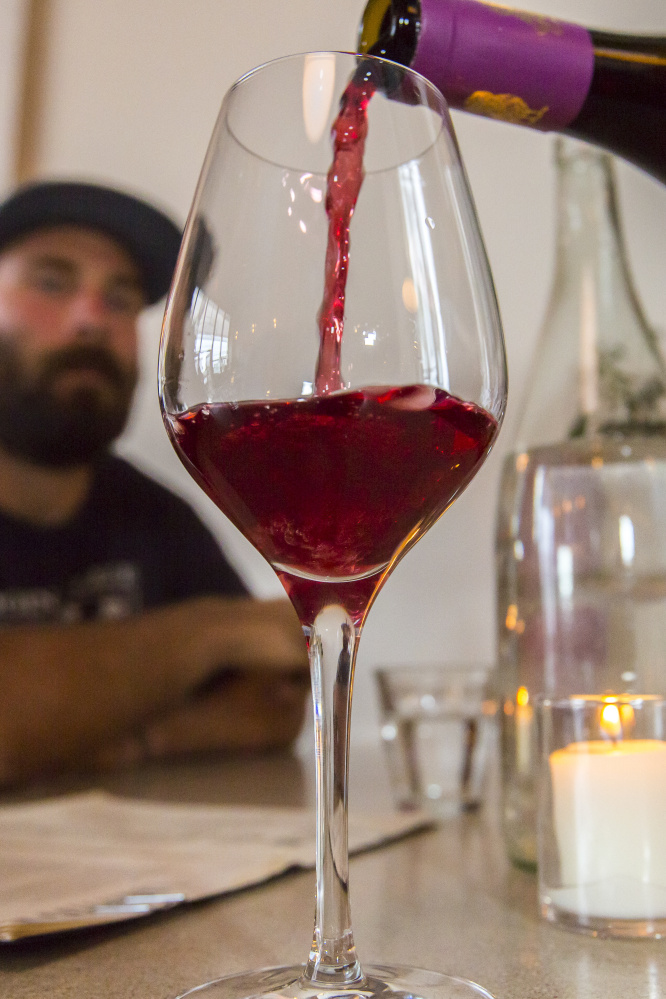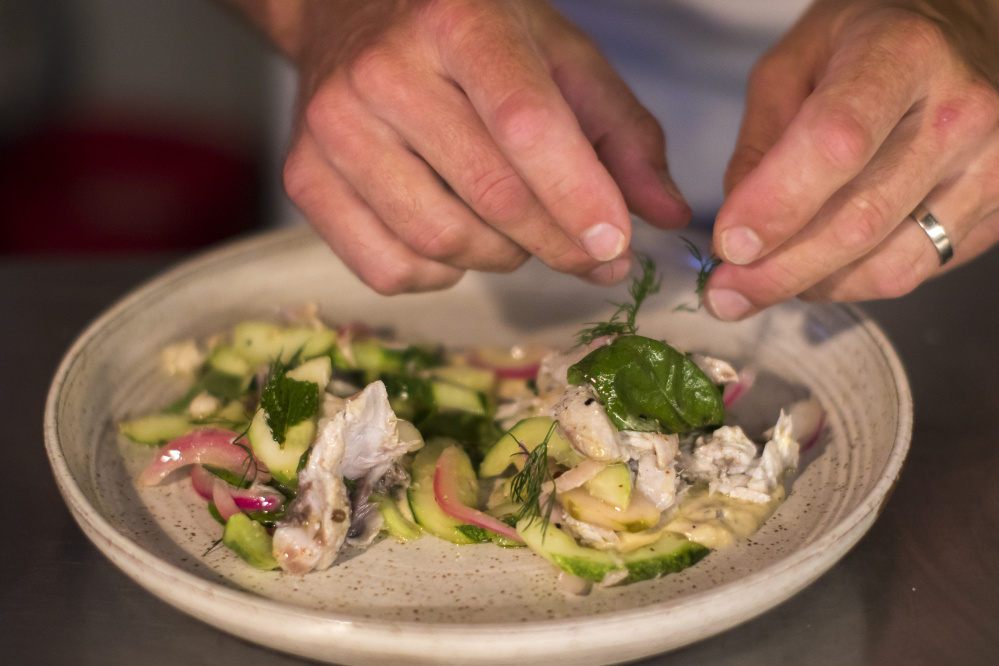Even though their natural wine shop, Maine & Loire, opened first, 18 months ago, co-owners Peter and Orenda Hale always planned to build a wine bar in the shared space. “But we were expecting a baby and couldn’t do it all at once. On a totally selfish level, we chose the store because we kept asking ourselves, ‘What are we going to drink?’ ” Orenda Hale said. Once their son was born, they were able to turn the front two-thirds of their high-ceilinged Washington Avenue storefront into the charmingly chic restaurant, Drifters Wife.
Knowing that wine informs so much of the Drifters Wife experience, I wanted to visit with someone with a passion for the stuff, someone for whom wine is a polestar. So I brought along the Press Herald’s wine writer, Joe Appel. We dined at Drifters Wife and decided to organize this review with questions and answers that reflect our conversation as we drank glasses of savory Domaine Dupasquier 2012 rosé ($11) and unfiltered and stone-fruit scented Caneva da Nani “Col Fondo” ($11).
Ross: What’s your impression of the wine selection at Drifters Wife (both bottles and glasses)?
Appel: I love the list overall, because it has so obviously been put together according to one criterion above all others: the personal passions of the people who run the place. You don’t have to be really into wine to see that they’re not taking the obvious route, with prestigious names, bottles that are easy to sell, etc.
The Hales’ “wine ethics” focus on organic or similar-practice viticulture, the use of native yeasts and small-scale production. They’ve chosen wines that are expressive, that offer themselves up undoctored, that teach us something new about the world. That’s noble. Also, it takes a lot of guts to fill a list with names of producers that are this unfamiliar to the majority of the area’s wine drinkers.
I’m grateful for how reasonably priced the wines are. There are some incredible values there, whether you’re paying $34 a bottle or $84. As a wine retailer myself, I’m acutely aware of many bars’ and restaurants’ obscene mark-ups, often on far inferior wines to the ones at Drifters Wife, meant to trick customers into paying a premium for lifestyle ego massage. The wine prices at Drifters Wife are intended to get people to try new things. Again, noble.
I’d like to see Drifters Wife add more of the New World wines from the new generation of vintners in the United States, Australia and Chile, among other places, making extraordinarily distinctive wines, with the viticulture and wine production taking place according to the same “natural” principles the Hales hold dear.
Also, the strength of the list is its bottles. The by-the-glass list is short, and I haven’t noticed enough of the offerings rotating as frequently as they could. This is meant to be a wine bar, not a full restaurant, and the majority of wine that is consumed there is by the glass. It’s frustratingly tantalizing to see such a deep, varied list of bottles but not easily be able to sample its true breadth.
Appel: At most restaurants, the role of the beverage program is to support the food menu; reasonably or not, liquids are seen as secondary. At Drifters Wife, that relationship is inverted. How do you see the connection between food and wine at Drifters Wife, and what do you think of the food?
Ross: Before I arrived, I thought that the balance between attention paid to food would be about 20:80, in favor of wine. But when I read the evening’s menu and started eating, I very quickly realized that it’s much closer to 50:50, maybe 40:60, but overall, very even.
One thing that makes this parity of attention clear is the fact that executive chef Ben Jackson (formerly of Diner and Reynard in New York’s Wythe Hotel) changes the eclectic, mostly modern American menu very frequently, sometimes every single night. This quicksilver approach means he can’t put together a stagnant menu comprising wine bar greatest hits, like quiche and salmon salads. Instead, Jackson challenges himself every day to be adventurous and innovative – incredible, when you stop to consider that his entire kitchen is made up of an oven and two induction burners.
A great example is his revelatory, ultra-tender beef tongue, served with bitter local puntarelle greens and farro ($17). Jackson marinates the tongue in a salt-free bath of spices for 24 hours, then cooks it all day in a low oven, seasons the deeply flavored broth, and adds roasted aromatics, plus, in Jackson’s words, “just about any herb you can think of,” such as basil, parsley and mint. It may sound like a haphazard process, but it is not; the flavors and textures are clear and precise.
Even more impressively, the balance of fat (beef tongue is surprisingly fatty), pungent aromatics, and bite from the puntarelle sets up an ideal backdrop for a range of wine pairings. While eating this dish, we both drank a lemony, mineral Chasselas (Dominique Lucas Quintessence, $48 for a bottle), and every once in a while, I snuck in a few sips of that rosé I mentioned earlier; both yielded different, equally compelling experiences.
For me, this is one of the things Jackson does best: He produces creative dishes that adapt to the context of the wine you drink with them, yet they never feel like neutral options.
I also love how the entire team rejects a doctrinaire stand on pairings: “We trust Ben to do what he wants. If you have good enough wine and good enough food, it’s pretty rare that you’d screw it up,” Peter Hale told me.
Ross: What are the complications and hurdles in building a wine list for a restaurant like Drifters Wife, especially in light of its focus on natural wines?
Appel: Here in Portland, the Hales are building something from close to the ground up. That’s dangerous; you risk sending people somewhere else to get a beer or malbec. Not all the wines at Drifters Wife are funky, super mineral, limpid to the point of nudity or wild-tasting, but many are. The challenge is making the connection for people between these wines and the food, beer and cocktails they already like. The challenge is to show people that, actually, these wines are closer to what wine has been historically than what they might be used to.
Ross: What should diners be on the lookout for at a place like Drifters Wife – wines or styles they might find nowhere else?
Appel: Well, the list of wines they might find nowhere else, or only in one or two other places, is long. But my first suggestion overall would be to seek out the wines of unfamiliar colors – orange wines, vins jaunes, some of the more interesting rosés. Also, the sparkling wines are great in ways that are both unconventional and immediately gratifying and delicious.
One of the most dramatic set of differences that wines made “naturally” exhibit is interesting textures, rather than flavors. So, explore the many white wines on the list that achieve levels of tannin and viscosity ordinarily associated more with reds. Ask whoever is working to point you to some of these. Peter, Orenda and Alexis (our server) are not only enthusiastic about their wines, they have the rare ability to describe them in quite precise, useful ways.
Appel: What sort of dining experience do you think works best for someone visiting Drifters Wife? Is it more suited to solo or couples’ dining than a group, or vice versa? Does it function as a place to go for a full meal?
Ross: It’s easy to picture yourself at Drifters Wife with a date, snacking on broccoli florets glazed with preserved lemon and golden raisin vinaigrette, and dipped in briny anchoide ($8), or sharing a crisp Red Russian kale salad with buttery, crunchy brown breadcrumbs ($8). I can definitely see myself doing the same while sitting at the bar, sipping a glass of the Pierre Olivier Bonhomme Le Telquel ($12) – a very softly tannic Touraine gamay blend, full of berry and spice.
But I think small groups of three to six diners would fare equally well, especially because with an increase in head count comes opportunity to explore the exciting list of bottles, even the more expensive ones, such as the legendary Domaine Tempier Bandol ($86), a gorgeously structured mourvedre blend with just enough cinsault in the mix to send up tiny sparks of anise as you drink.
In terms of constructing full meals, I don’t see Drifters Wife as being different from most small-plates restaurants. Even with only eight menu items, there’s a breadth of size, flavor and type of dish – from bluefish and cucumber marinated in apple cider vinegar, basil and dill ($11) that reminded me of the filling from a perfect whitefish salad bagel, to an unmissable dessert, the malabi pudding with strawberries ($8). This simple Middle Eastern milk pudding is also another example of Jackson’s genius for not getting in the way of the wine; the pudding is calibrated to be sweet but also just savory enough (thanks to a little Maldon sea salt) that it doesn’t coat your palate and leave you unable to finish any leftover wine. You really can have your dessert and drink it, too.
Andrew Ross has written about food in the United Kingdom and in New York, where he co-founded NYCnosh, a food website. He and his work have been featured on Martha Stewart Living Radio and in The New York Times. He is an internet researcher and higher education consultant. Contact him at:
Twitter: @AndrewRossME
Send questions/comments to the editors.





Comments are no longer available on this story